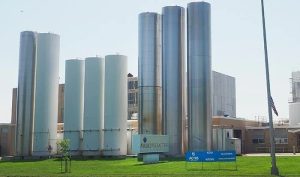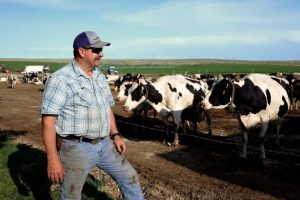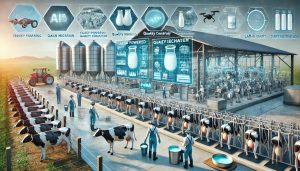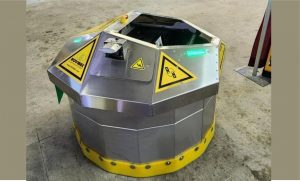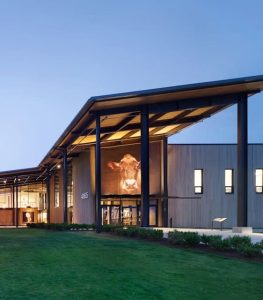
In response to the request of many producers about the need for more information and knowledge about new technologies, their usefulness and how they can impact on dairy production systems, Ricardo Garro from the Anguil Experimental Farm at INTA in La Pampa, Argentina, talks to us together with Miguel Taverna, president of FunPel, dairy referent for INTA and Club Tambero, about what Smart Dairy is.
Precision Livestock is a growing demand from different sectors that made visible the need to start working in a much more solid way on a concrete project that focuses on the development and validation of technology and the search for public-private partnerships to promote new developments.
Private companies are interested in the development of technologies for livestock farming, which is much more neglected than precision agriculture, because it is always more complex to develop technology on a live animal than on equipment or machinery.
But what is precision livestock farming? It is obtaining as much information as possible about the environment in which the cows are in, and on the cows themselves. So we can have an electronic collar to geoposition the animal that is moving within the lot, on the animal, or on the infrastructure, which can be cameras, antennas, etc.
The dairy farm is a very interesting place to incorporate technology because there are much more stable conditions and the work methodology is focused on each individual animal. It is not a new way of approaching daily life for the dairy farmer.
What about Intelligent Cattle Raising? It is one more twist on the data that Precision Cattle Raising takes, where higher level technologies such as Artificial Intelligence start to be used to find behavioral patterns, patterns of circumstances of the establishment, information that a person looking at an excel could not detect at first sight. Intelligent Cattle Raising goes a step further, where systems generate work proposals to make better decisions based on a large volume of data.
Ricardo tells us how a conventional dairy farm is going through the stages from Precision Livestock Farming to Intelligent Livestock Farming: when entering the dairy farm, the animals are identified with an electronic caravan, and each one receives a controlled ration, according to the nutritionist’s prescriptions for each individual in particular. By scaling up on this data incorporation, we are starting to work with lactometers and other large volumes of data, and Artificial Intelligence algorithms make this concept even more efficient, and not only does the nutritionist’s prescription play a role, but the system, based on the behavior of the animals, makes recommendations to improve the situation of each individual, which has led to substantial improvements in supplement savings, the animals’ body condition and also in milk production.
The dairy farms that are adopting these technologies are increasing in numbers compared to those that did not. The impact is strong and clear.
It is based on the premise of incorporating technology, but without having to modify the entire farm to implement it, but with a minimum modification, at an affordable cost so that those producers who have between 200 and 300 animals can incorporate a development and use it to generate information from which to make better decisions that will significantly modify production and profitability.
In Australia, where Ricardo is doing an internship, they are analyzing calving positioners, which are intravaginal devices that fall when calving begins, generating an alert that indicates where the calf is, and pedometers to analyze movement patterns. Today, the range of monitoring possibilities is quite large, but it is still in its initial stage, especially the collars, which, although they have evolved a lot, are still a bit big. The biggest challenge for these technologies is the size and autonomy of the batteries.
Today, rural areas have a big problem with connectivity, limiting the possibility of real time, but other technologies are also appearing that allow having many connected devices for an accessible amount, so little by little more solutions are appearing to put on the animals and on the infrastructure, which are very encouraging for the future, which will help to make more efficient decisions and to think at individual level and stop talking about the herd average, since there are animals that are above the average and others that are below it. Then it will be possible to explain from the individual level that final number, and make decisions from the individual to the group level, facilitating the anticipation of some situations, for a more efficient use of resources.
Dairy cows are the most connected animals in the world, and these technologies that have come to stay are applied more in dairy in other types of livestock, incorporating progressively and showing very decisive changes in production.
Many times when we talk about the technification of dairy farms we think directly of robots, however, there are many technologies that can work by providing solutions to specific problems that each producer may have, which do not necessarily involve the automation of milking.
If the problem is sanitary, the technology should be used to solve that issue, rather than others that do not provide a relevant utility at that moment. If the problem is reproductive, with a sensor and the identification of each animal, technology can be added to help detect estrus and define the optimum moment for insemination.
The relevance of the technology in relation to the problem that needs to be solved is fundamental, being able to progressively incorporate later other technologies that make other contributions. This technology must also be easily adoptable and understandable by those who are going to apply it, so that it really makes a difference in profitability and production.
Trial programs are available to evaluate if the technologies are suitable for the farmer without having to purchase them first. It is also useful to visit colleagues who are applying the technology of interest and can share their experience.
Routine recording of what happens in the dairy is often a difficulty for producers and their collaborators, and it is very difficult to manage when there is a lack of data and records. The cost-benefit ratio in the adoption of these systems is determined by the management of the information they generate. Less than 50% of dairy farms generate information for management purposes. Technologies simplify the capture of information and help to decide what to do with it.
The most important of the advantages of using technologies is the anticipation in the detection of situations that require different actions. For example, mastitis, in which detection necessarily involves testing the first spurts, an operator attentive to the detection of lumps, and also observing udder inflammation… Sensors allow us to anticipate this three or four days, so treatment will be more effective and we can use less antibiotics and losses are lower.
Also for heat detection, an operator with time and lucidity is needed to identify each animal among the whole herd by observing it and then establish the action to take; when with the right technology we can know the exact moment of heat without taking all that time of the operators and with the risk of missing valuable opportunities.
The disadvantages are, on the one hand and as always, the cost, which fortunately and as with any technology, as it becomes more widespread, its relative cost is reduced; and on the other hand, the challenge that implies for the user to use them properly so that their implementation translates into greater efficiency and thus justifies the investment.
The experience can be lived in different ways by each producer, but except in some cases in which the difficulty in training personnel can be more cumbersome, in general it is always positive and results in a less laborious, more efficient and more pleasant production for all, men and animals.
In any case, it is not minor that the bottleneck is the personnel and their training, especially taking into account the high rotation in the dairy farms. It is necessary to propose a training strategy in the use of technologies and that somehow includes a loyalty in the labor relationship.
Today we have a very interesting technological offer, all the international and local developments. We have automatic identification of cows, measurement of milk production, individual feeding management, health management through different sensors, heat detection and reproductive and calving management, also linked to different sensors that are linked to different software that cross-reference the information and help us make better decisions.
We have heat stress, panting and forced breathing sensors, which allow the automatic activation of sprinklers and the consequent cooling of the animals when they need it most, not only guaranteeing more comfort to the herd, but also a substantial saving of water and energy.
Technology is an indisputable and accessible ally for small and large producers, who accompanied by a visionary philosophy and supporting their decisions on the solidity of reliable information, will reach solutions that will contribute to their quality of life, that of their personnel and their animals, which will increase their productivity in this synergy of well-being.
The future is here, and I ask myself, Mr. Dairy Farmer, have you had your glass of milk today?
Consuming dairy products is good for you, and producing them is a fascinating task, full of challenges, love and infinite possibilities of innovation in the ways of managing its production.
Valeria Guzmán Hamann
EDAIRYNEWS




